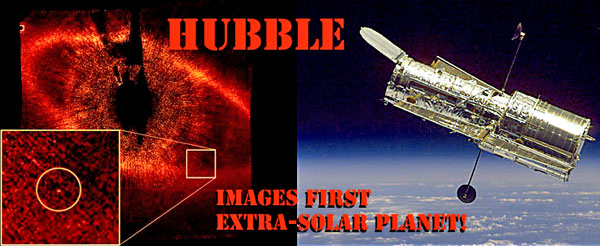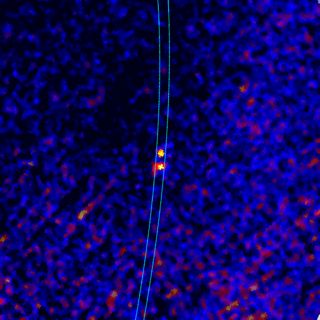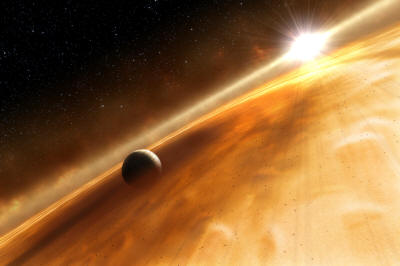|
|
|
from ScientificAmerican Website
Two groups of researchers searching for extrasolar planets - planets orbiting stars other than our own sun - laid claim today to an astronomy milestone:
A team led by astronomer Paul Kalas of the University of California, Berkeley, detected a planetary candidate orbiting Fomalhaut, a star 25 light-years away in the constellation Pisces Australis (the Southern Fish), using visible-light observations from the Hubble Space Telescope.
Another group, led by astronomer Christian Marois of the Herzberg Institute of Astrophysics in Victoria, British Columbia, used infrared to image a family of three planets orbiting HR 8799, a star nearly 130 light-years distant. (Marois was also a member of Kalas's group.)
Both teams report their findings online today in the journal Science.
MOVING RIGHT ALONG: The first visible-light image of what appears to be a planet orbiting the star Fomalhaut, 25 light-years away.
In this composite,
the object's position in 2004 [below] and in 2006 [above] follows
its projected counterclockwise orbit [green lines].
Of the more than 300 other known exoplanets (see below insert), all have been detected indirectly by their effects on their parent stars - either a wobble in induced by the object's orbit or a decrease in detected light from the star as the planet passes in front of it.
Other photographed objects have been too massive to be conclusively labeled planets, falling instead into the brown dwarf category (objects about eight to 80 Jupiters in size that lack sufficient mass to ignite hydrogen fusion in their cores, thereby never becoming true stars), have been found to themselves orbit brown dwarfs rather than stars or have not been shown to be gravitationally bound to a star.
Kalas and two of his co-authors, astronomy professor James Graham of U.C. Berkeley and astrophysicist Mark Clampin of the NASA Goddard Space Flight Center in Greenbelt, Md., had ventured in 2005 that Fomalhaut should harbor planet-size objects in its orbit, based on the disk of dust ringing the star.
By looking at Hubble images from 2004 and 2006, Kalas and his colleagues were able to track a speck, dubbed Fomalhaut b, inside that ring that seemed to be orbiting the star.
Fomalhaut b is significant for its small size, estimated to be between the mass of Neptune and three times the mass of Jupiter, which would place it squarely in the realm of planets.
An object larger than about 13 Jupiter-masses is considered a small brown dwarf rather than a large planet.
The planet, he says, "can't possibly be
more than three Jupiter-masses," because a more massive object would
clear its gravitational sphere of debris, meaning that the dust belt
would have to be farther away than it is.
As a result, they lacked data points describing the object and, so, still had to make some inferences about it.
Marois and his team used ground-based infrared detection to seek out exoplanets around nearby, young, massive stars - those whose planets would have wide orbits and emit significant amounts of radiation as they cool from their relatively recent births millions of years ago.
After narrowing some 80 candidate stars to 20 "really, really interesting" ones with infrared excess (indicating the presence of orbiting dust), the researchers settled on a particularly appealing star.
By comparing data captured by various telescopes in 2004, 2007 and this year, Marois's group selected three objects, all estimated to be below the brown dwarf threshold, orbiting HR 8799.
The innermost exoplanet around HR 8799 has an orbit that would place it between Uranus and Neptune in our solar system. (Fomalhaut b, by contrast, orbits at nearly twice the distance of the farthest-flung planet around HR 8799, albeit around a larger star.)
Marley acknowledges that the exact mass
of the objects could be called into question, even pushing two of
the masses into the realm of brown dwarfs, but does not view that
uncertainty as a deal-breaker given the magnitude of the discovery.
Toward that end, Kalas is awaiting the repair of the Hubble's Space Telescope Imaging Spectrograph, which failed in 2004, to give a more detailed look at Fomalhaut b. Hubble could also help confirm the exoplanet's status next year by photographing it farther along its predicted orbital path.
As for Marois,
November 17, 2008
from
ScientificAmerican Website
Using a technique called adaptive optics, astronomers were able to produce the first image of an entire solar system far from ours.
The following is an exact transcript of this podcast:
|




